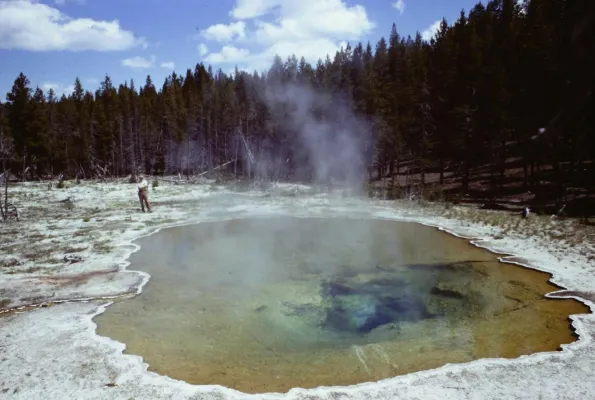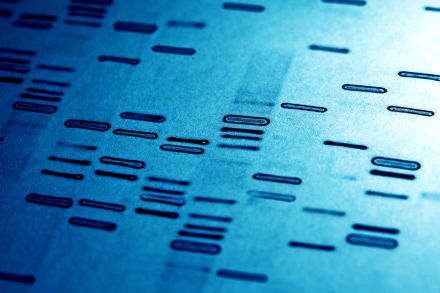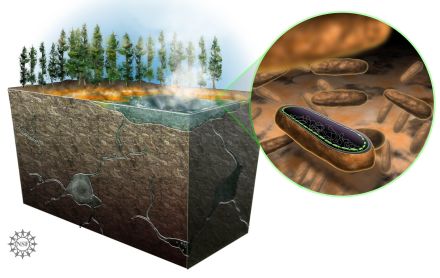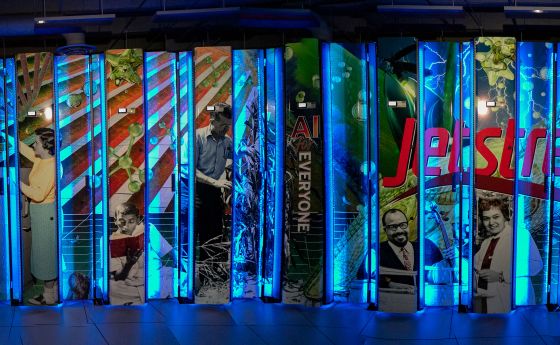
Biotechnology sector materializes from Yellowstone hot springs
The word biotechnology brings to mind images of researchers developing new diagnostic tests and drugs in futuristic labs; new methods of farming and food production that meet the requirements of a growing population; and environmentally friendly products that replace petrochemically derived non-biodegradable materials that can linger in landfills for decades.
A large portion of this future — and the present — can be traced to hot springs, some of them located in Yellowstone National Park, and field work conducted by a pair of scientists beginning in the 1960s.
From curiosity driven field work …
In 1964, Thomas Brock stopped in Yellowstone, which is spread across parts of Wyoming, Montana and Idaho, during a long car trip and by chance happened upon a ranger talk beside a thermal pool with blue-green algae. Brock, then an associate professor of microbiology at Indiana University, was curious about how this microorganism could inhabit, perhaps even thrive, in this extreme environment. Brock and his team began studying the hot springs environment and the organisms that lived there under a three-year grant from the U.S. National Science Foundation.
Brock continued his work through 1975 and, along with undergraduate student Hudson Freeze, isolated a bacterium that thrived at temperatures between 65 and 70 degrees Celsius (149 to 160 Fahrenheit). They named it Thermus aquaticus. This work spawned the worldwide study of extremophiles, organisms that flourish in extreme environments. Brock's discovery not only added to our understanding of the diversity of microbes, but also enabled new research by scientists based much closer to Yellowstone than Indiana University.
That research focused on examining DNA molecules to determine how the genetic material replicated. Scientists were looking for a more robust version of DNA polymerase — an enzyme found in all living organisms that is critical to DNA replication — that they could use to replicate DNA enough times to analyze it in the lab. In 1976, scientists at Cetus Corp. were able to isolate the DNA polymerase in T. aquaticus, which are naturally adapted to high temperatures and enable the bacterium to live in the hot springs. These DNA polymerases were significantly more efficient in the lab than previous enzymes.
Using Brock and Freeze's discovery, Kary Mullis, head of the DNA synthesis lab at Cetus, created a procedure called PCR that used the adapted enzymes to replicate DNA with great efficiency and precision. These enzymes, named Taq (named for Thermus aquaticus), are still in use in labs all over the world.
Mullis was awarded the Nobel Prize in chemistry in 1993, and the field of biotechnology took off.
… to a biotechnology revolution
The ability to amplify copies of DNA through PCR has resulted in numerous advances and new innovations over the past four decades, including more accurate tests for diseases, new drugs and vaccines, and tools to identify similarities between sources of DNA. PCR also is being used in environmental areas to track pollution and monitor ecosystem health.
A process called DNA fingerprinting identifies sequences of nucleotides in DNA that are unique to a particular individual. The patterns of these nucleotides can be identified when tiny amounts of DNA are amplified by PCR. DNA fingerprinting enables the legal community to accurately identify people, providing the ability to show a suspect's involvement in a crime or demonstrate innocence of someone wrongly accused. These techniques are also used to track endangered species and determine the source of possibly illegally hunted animals, to conduct genealogical research and find long-lost family, and to identify patients' risk for developing many diseases.
In 2020, in response to the COVID-19 pandemic, researchers applied PCR to detect the virus in patients, amplifying the small amount of genetic material retrieved through a nasal swab to a measurable quantity, as well as in wastewater, to detect the presence of the virus in communities.
The combined global biotechnology market — from PCR to new crops and chemical manufacturing — was valued at $793.87 billion in 2021 by market research firms and is expected to expand to over $1.68 trillion by 2030.
NSF driving innovations
Today, NSF supports programs and provides funding opportunities for biotechnology in four priority areas: foundational research, infrastructure, workforce and translation. New biotechnologies will advance the U.S. bioeconomy, accelerating scientific discovery and the harnessing biological systems to create goods and services that contribute to agriculture, health, security, manufacturing and climate resilience.
NSF continues to support the research that makes those biotechnologies possible. Investigation into the function of the protein Cas9 and how it disrupts viral DNA in bacteria, along with years of research, led Jennifer Doudna and Emmanuelle Charpentier to produce a method to cleave DNA molecules at extremely precise locations, called CRISPR. This technology is used to edit DNA sequences and has numerous applications in medicine, such as diagnosing infectious diseases, and is being used to develop new methods to fight the impacts of climate change, such as creating drought-resistant crops. The work earned the researchers the 2020 Nobel Prize in chemistry.
NSF's SBIR/STTR program, also known as America's Seed Fund, awards over $200 million each year to about 400 startups and small businesses to transform scientific discoveries into products and services. One such company, Ginkgo Bioworks, specializes in using genetic engineering to produce bacteria with industrial applications, and many other small biotechnology companies that are now fueling the economy through their discoveries.
And NSF-supported researchers continue making discoveries in Yellowstone National Park. In 2009, grantee Mark Kozubal was seeking out new life-forms that thrive in the acidic hot springs of Yellowstone. The fungus he discovered, later dubbed Fusarium strain flavolapis, or yellow stone, is now used to produce meatless breakfast patties and dairy-free cream — with no need for sun, soil or rain.
In 2007, a team of researchers discovered a bacterium in the same hot spring where T. aquaticus was found that transforms light into chemical energy. Candidatus chloracidobacterium thermophilum has special light-harvesting antennae known as chlorosomes, which each contain about 250,000 chlorophylls. No member of this phylum nor any aerobic microbe was known to make chlorosomes before this discovery.
"Finding a previously unknown chlorophyll-producing microbe is the discovery of a lifetime for someone who has studied bacterial photosynthesis for as long as I have (35 years)," Don Bryant, a professor at Penn State, said at the time.
And over the next five decades, who knows what innovations will owe their discovery Cab. thermophilum?





